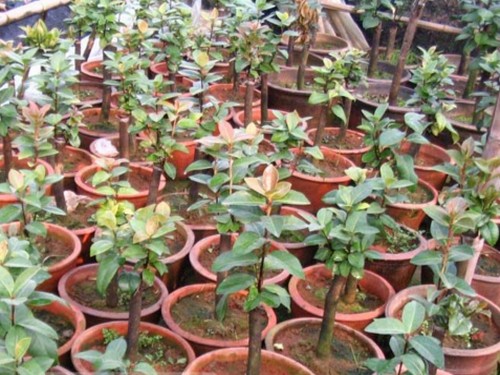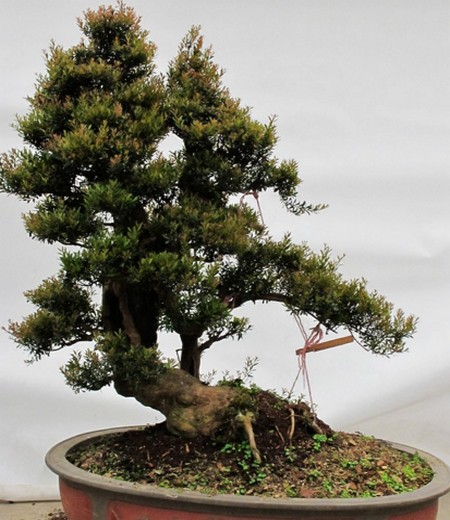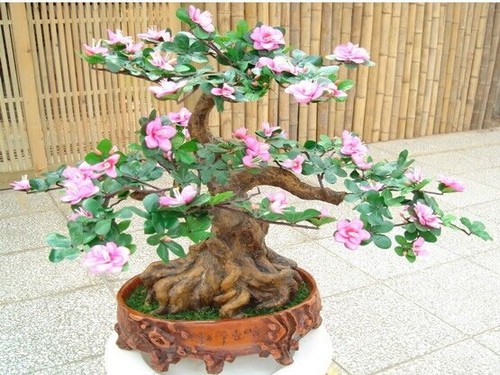How to water Yunnan camellia bonsai
Dali, which is famous for its four beautiful scenery of "romantic flowers and snow moon", especially flowers have the most shape and spirit compared with the wind, snow and moon which are hard to find and ethereal. Among the colorful brocade flowers in Cangshan and Erhai Lake in Dali, camellia, which is called the first in the world, is the most famous.
Camellia yunnanensis, which ranks first among the eight famous flowers in Yunnan, belongs to the family Theaceae and genus Camellia, also known as Camellia or Camellia, Nanshan Camellia and Camellia. It is an ancient plant and a specialty of Yunnan, with more than 150 varieties. It is characterized by evergreen, large flowers, colorful tree type, blooming in winter and spring and long flowering period, forming a unique landscape highlight of the Yunnan Plateau. Cultivation in Yunnan has a long history of 1500 years, and it has the reputation of "Yunnan camellia is the first in the world" as early as the Ming Dynasty in China.

How to water camellias in Yunnan:
1. Water quality requirements
Soft water is better for watering Yunnan camellia, but hard water, alkaline water and salty water are not suitable. Generally available river water, pond water, spring water, well water and tap water.
2. Watering principle
Camellia yunnanensis is an evergreen woody plant. In order to ensure the normal growth of the plant, watering should be correct and reasonable. Whether potted or planted in the ground, the soil of Yunnan camellia should always be kept moist. Too dry and too wet are disadvantageous to plant growth. There are some differences in the demand for water in different growing periods of Camellia yunnanensis. Camellia vegetative growth and reproductive growth are exuberant from spring to early summer. During this period, new shoots grow and flower buds differentiate, which should be watered frequently and more. The temperature is getting lower and lower in autumn and winter, and the physiological activities of camellias are relatively weak. at this stage, the buds are developed and expanded, so watering should be properly controlled and watering times should be reduced. During the flowering period of Camellia yunnanensis, the plant needs sufficient water supply and should be watered more timely.
3. Watering time
The watering time of potted Yunnan camellia is different according to different seasons. it is better to be watered in the morning or afternoon in spring and autumn, hot in summer, before 10:00 in the morning and in the evening, and relatively low in winter. Watering in the afternoon is better. Do not water at noon on sunny days, especially in summer, because of the high temperature at noon, the soil temperature drops suddenly after watering, which is disadvantageous to the root growth, thus affecting the normal growth of the plant. The degree of dryness and wetness of camellia pot soil is not only related to season and weather, but also to air temperature, air humidity, sunshine length, shade degree, soil water storage capacity and so on.
In the same season, the same weather, the dry and wet degree of the camellia pot soil is not necessarily the same, the actual observation of the dry and wet soil can be used to determine whether watering. There are three methods: one is to look at the soil color, the soil white is dry, the soil black is wet; the second is to knock the basin to listen to the sound, clear is dry, turbid and stuffy is wet; the third is to touch the mud to twist the soil, the mud is hard for dry, the mud is soft for wet. It is more scientific and reasonable to determine whether potted camellias need to be watered through the above seeing, listening and twisting.
4. Watering method
Potted Yunnan camellia is generally watered by direct watering combined with foliar spraying, with available ladle or long-necked watering pot, or plastic tube watering. When watering, we should pay attention to the flow of water, soak the basin soil evenly and slowly as far as possible, especially with plastic pipes, it is difficult to control because of the water pressure, it is best to lay a layer of pine needles or a tile on the surface of the basin soil to protect the soil from being washed by water. Each watering, must be thoroughly watered, to the basin bottom drain until the water, do not irrigate half of the water to make the basin soil wet and dry.
For the potted flowers whose leaves are sloping or the leaves are slightly green due to poor management, the potted flowers can not be watered immediately, so the plants should be moved to the shade place first, and the pot soil should be slightly moist with a little water, and then watered through 2-3 times to gradually adapt to restore the normal growth of the plants. In the season of drought or high temperature, foliar spraying can be increased once a day, either in the morning or evening. Spraying water on the leaf surface can not only increase the air humidity of the small environment, but also wash away the dust on the leaf surface, make the leaves clean and beautiful, facilitate photosynthesis and respiration, and reduce the occurrence of diseases and insect pests.
Time: 2019-06-12 Click:
- Prev

Modeling method of bonsai pile
Chinan has become a good wood for bonsai production because of its dense branches, small leaves, green all the year round, strange pile shape, various shapes, staggered branches, strange roots, wide adaptability, easy management and so on. However, a perfect bonsai of Chinan must also be processed by artificial art and trimmed so that the pile scenery does not grow tall.
- Next

Modeling Technology of Camellia Bonsai
Camellia is one of the top ten famous flowers in China. With the characteristics of not withering through winter, fighting frost, proud snow and cold, camellia is dressed up as a garden in winter and early spring. If used in bonsai, it can brighten and invigorate the room with the natural combination of elegant and dignified plant shape, bright green leaves and beautiful but not demon flowers.
Related
- Fuxing push coffee new agricultural production and marketing class: lack of small-scale processing plants
- Jujube rice field leisure farm deep ploughing Yilan for five years to create a space for organic food and play
- Nongyu Farm-A trial of organic papaya for brave women with advanced technology
- Four points for attention in the prevention and control of diseases and insect pests of edible fungi
- How to add nutrient solution to Edible Fungi
- Is there any good way to control edible fungus mites?
- Open Inoculation Technology of Edible Fungi
- Is there any clever way to use fertilizer for edible fungus in winter?
- What agents are used to kill the pathogens of edible fungi in the mushroom shed?
- Rapid drying of Edible Fungi

